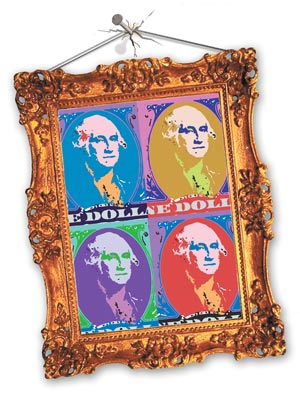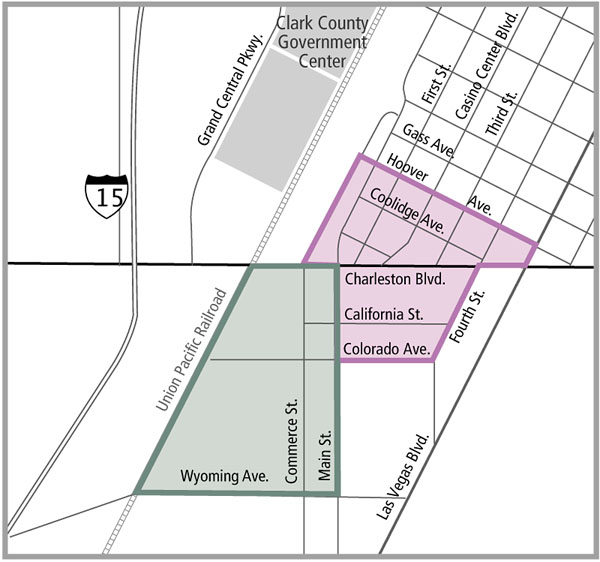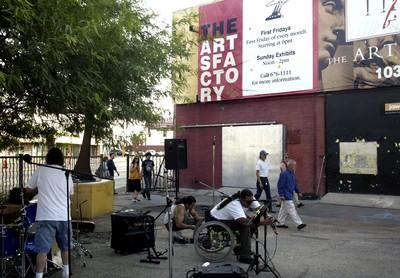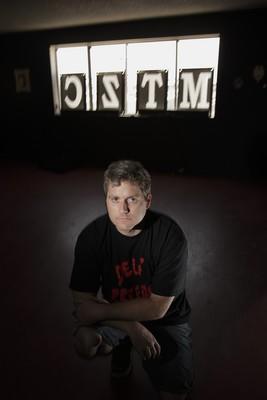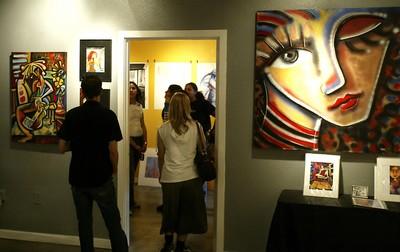Painted into a corner
Nathaniel Ward is explaining one of his abstract acrylic paintings to a woman who has entered his tent at First Friday, the street fair that draws approximately 10,000 Las Vegans to the Arts District each month.
"It's a lady laying down," the 27-year-old artist says, pointing to the first 15-inch square canvas in his series of three. "Her head is right here. And this is a pillow."
"Oh, I didn't see that!" replies Citizens Area Transit bus driver Sandra Bacote. "That is too awesome!"
Farther west along Colorado Avenue, a woman who identifies herself as Elaine X shouts into a microphone for a small but rapt crowd.
"Yes, I'm possessed by demons!" she spews. "I call them my neighbors!"
The Arts District's newest neighbor could be Michigan-based Real Estate Interests Neon Group, which plans to build a $9.5 billion arena/casino/hotel/condo/retail complex, called Project Pulse, on 85 acres between Charleston Boulevard and Wyoming Street, and Main Street and the Union Pacific Railroad line.
While it's hard to argue the redevelopment of a neighborhood ravaged by six decades of economic decline is not a good thing, many believe there already is a good thing happening in this one.
Displacing seven of the district's 25 art galleries is just the immediate threat posed by Project Pulse, say some gallery owners, artists and art patrons. They're worried about the long-term effect of raised rents on what they consider the valley's only homegrown cultural institution.
"People are moving to Las Vegas from places that already had established cultures," says local painter Dray. "They're finding out that there's art going on here, and they're digging it. But before it's getting to the level that it needs to be, it's being trampled on a little. It's like an infant you don't even give a chance to grow before you stick a beer in its mouth."
"Las Vegas thinks it can fast-track everything," agrees gallery owner Michael Wardle, who rents space at the Arts Factory at 101-107 E. Charleston Blvd., "but there's a natural evolution that has to happen. Any arts district that exists now, anywhere in the country, was preceded by between 10 and 30 years of cheap rent for artists."
EDGY ARTISTS AND CHEAP RENT
Prime retail space in the Las Vegas Arts District now fetches $1 to $2.25 a square foot per month, plus maintenance. This range is likely to double if REI Neon's plans are realized.
"The development of the project is probably going to eliminate some of the lower-cost gallery space," says REI Neon spokeswoman Lee Haney. "If these people lease space and don't own their own galleries and the landowner is willing to sell, unfortunately for those galleries, they're going to have to be moved."
Moving is not a likely option for many of those galleries, however -- at least within, or anywhere near, an upscaled arts district.
"The art that I like to show is a little more underground and a little edgier," says Mark T. Zeilman, painter and proprietor of MTZC at the Commerce Street Studios at 1551 S. Commerce St., one of three arts-related buildings REI plans to bulldoze. "So, in a community that's just started to happen, it doesn't generate a lot of money."
Zeilman -- who works full time as a purchaser for a lighting rental warehouse -- says he has paid his gallery's rent solely with its profits "probably twice in the past 2 1/2 years."
"And that's part of my plan," he says. "I want to show art that I dig, not just stuff that goes with a couch."
Zeilman says a gentrified district will leave little wall space to any talented artist whose name can't command $5,000 per piece.
"We'll get driven out," Zeilman says, "and what you'll be left with will be less about artists with voices and something controversial to say, and more about Snoopy paintings."
That possibility doesn't sit well with Stephen Hendee, coordinator of the master's of fine art program at the University of Nevada, Las Vegas. He says that underground art is vital to the credibility, and longevity, of any arts district.
"Anything that desires to be different for the sake of being in opposition, or expressing a unique language, is incredibly powerful," he says, "and that in itself is a form of diversity."
Artists first established a foothold in the district 10 years ago, when entrepreneur Wes Isbutt opened the Arts Factory as a cultural beacon in a sea of homeless shopping carts and discarded needles. (Today, the former crematorium houses 11 galleries.)
"I'm not saying that there won't continue to be artists there," says Jacie Maynard, interim vice president of the Contemporary Arts Collective and fine art consultant with L. Maynard Studios in Henderson. "I just don't know if our artists will be there. The LeRoy Neimans will be there, the Wylands and the representatives for the Picasso Collection. We'll see an extension of the galleries that are now at the Forum Shops.
"But what about our artists, these people who thrive on just the idea of being able to create something?"
FUTURE OF FIRST FRIDAY
First Friday -- launched five years ago by Funk House antiques shop owner Cindy Funkhouser and her partners in the Whirlygig nonprofit organization: Dust Gallery co-owner Naomi Arin and Julie Brewer, owner of the defunct Enigma Cafe -- goes out of its way to nurture these artists, providing tents free of charge. (The city requires that taxes be paid on all sales.)
There are no immediate plans to alter the festival, according to Funkhouser, who declined to grant a full interview because her co-owners in the Commerce Street Studios voted to sell to REI.
However, some are concerned that new upmarket property owners and tenants may decide to oppose it, particularly because of the empty-pocketed teenagers it attracts.
"If this goes into those high-scale art galleries, they'll cut off tomorrow's art buyers and artists," says John Robison, 27, whose sells skeleton-themed carvings from a First Friday tent. "I just think it's the wrong way to go. If you want to strengthen the Arts District, do it for everybody -- including the kids. I work in a behavioral school, and I see a lot of my kids out there. It's good for them."
DEVELOPER SAYS IT'S NOT THE BAD GUY
REI pledges not only to support, but to revitalize the Arts District. (Technically, it argues, Project Pulse won't even be built there. But that's because, in June, the city officially redrew the Arts District to remove the area Project Pulse would occupy.)
"We don't believe that our project and the Arts District need to be mutually exclusive," Haney says. "A few of the principals in REI are arts lovers themselves. So we're absolutely willing to continue to try and meet with them to identify ways in which we can work together."
REI's city-approved plans include retail space for galleries, public art and participation in a special improvement district. (The fees to pay for that district probably will be passed on to area renters.) The city also has agreed to give 2 percent of the incremental taxes associated with the project back to the Arts District and Arts District-related initiatives.
"We don't know what that means yet," says Las Vegas business development director Scott Adams. "But if the project happens and 2 percent goes into a fund, then we'd probably work extensively with the Arts District community on how those funds get invested back into the Arts District."
The fund could contribute as much as $20 million, according to Adams.
SOME WELCOME CHANGE
Las Vegas arts commissioner Jack Solomon, who owns the S2 Art Building at 1 E. Charleston Blvd., wholly supports Project Pulse and isn't waiting for any initiatives. Pending city approval, he says, ground will be broken on the first of four medium-rise buildings he plans to build in the 1000 block of Main Street. Featuring artist studios with galleries on the ground floor, he says, the spaces will rent for $2 to $2.25 per square foot.
"And we'll make sure we rent them to artists," Solomon says.
According to Solomon, Project Pulse will provide just as big a boost to the arts, and artists, as it will to property values.
"You're gonna see what happens in this Arts District that you've seen in a numbers of others," he says. "You'll get more people in coming downtown, and a good segment of those persons will have an interest in the arts."
This is what happened in the '70s to Manhattan's SoHo in New York. And Solomon should know; he was there at the time, as a renter, rather than an owner. Redevelopment transformed the Greenwich Village-adjacent neighborhood from a gang-infested ghetto where only artists lived, to a center for the arts that gained worldwide recognition. Galleries sprouted up in droves once shoppers felt safe enough to peruse the area.
The lesson that Project Pulse's foes warn that should be taken from SoHo comes from what happened there next, however. By the mid-'80s, rich professionals who fancied themselves artsy moved in, driving rents beyond the reach of the galleries. (That's why Solomon was forced out.) Now, about the only thing SoHo is a center for is Starbucks.
"The same phenomenon will happen here," warns Jim Veltman, the city's historic preservation commissioner for urban design and architecture, who recommended that Project Pulse be built instead across from Main Street Station.
"The Arts District is going to turn into a good place for higher-income people," Veltman says, "which is then going to displace the Arts District."
This is one of several reasons Las Vegas resident Charles Weiner cites for attempting to turn back Project Pulse. His attorney, Chuck Gardner, filed an appeal last month with the review panel of the state Gaming Policy Committee, seeking to stop the designation of the Arts District as a gaming district.
"We think it'll kill the Arts District if it gets built," Gardner says. "If they build a multiplicity of casinos there, the rents will become too high and the Arts District will go away."
That appeal was denied, but Gardner says he's preparing another.
NOTHING STAYS THE SAME
It should be pointed out that REI Neon appears to be less the bad guy here and more the inevitable one (barring a flip of the property, which it says won't happen). Gentrification has been under way in the district for at least three years. Developer Sam Cherry has broken ground on two of three high-rise condos he plans in, and directly bordering, the area. (One, coincidentally named Soho Lofts, is sold out and offering apartments for rent at $1,900 to $3,000 per month.)
A map on the City of Las Vegas Redevelopment Agency Web site, www.lvrda.org, shows 103 new construction projects approved for the Arts District and adjacent areas. And that map predates the Project Pulse announcement.
"In the past two years, I haven't heard of one lease being signed in the Arts District for more than a year," Wardle says. "Everybody thinks their property's worth $8 million an acre now, and the building owners don't want to jeopardize their opportunity to sell."
Back at First Friday, Las Vegas resident Wayne Schulatz, 26, holds up a Danny Roberts print he just purchased for $20 at Damned Ink Studios in the Arts Factory. Titled "There Was an Incident," it shows a man either loosening or tightening his tie. His dress shirt is stained red.
"This is real, this is now," says Schulatz, who teaches art to Canarelli Middle School students. "This is what is going on right here in this city with these artists. This isn't centuries ago in Europe. This is what people here, in this time, feel.
"And that's important."
ART ATTACK The possible exclusion of underground artists from a redeveloped arts district does not concern everyone. "The world doesn't owe them cheap rent," says Marty Walsh, owner of Trifecta Gallery, a renter in the Arts Factory, adding that "I've been staying very quiet about it because a lot of my peers are against it, but now I'm going to start voicing my opinion. "If you don't have a product that sells, either change your location or change your product," says Walsh, who shows a 50-50 mix of local and national artists and promises to keep doing so. "If the local artists I show now keep working and selling like they're selling now, then their prices are going to go up anyway -- not just because my rent is," she says. Arts commissioner Jack Solomon agrees. "I mean, plumbers go bust, too," he says. "I don't believe that artists need to be subsidized. A good artist can make a tremendous amount of money. You look at the prices for contemporary art at auction now and they're through the roof." Las Vegas Mayor Oscar Goodman comments: "There is only one side to this story. There are no Picassos in the Arts District." REVIEW-JOURNAL WHERE ART THOU GOING? If underground Las Vegas art gets forced out of the Arts District, could it reappear anywhere else? “We’re in the process of working with Henderson to see if there would be any artist-in-residency programs opening up or affordable rent,” says the Contemporary Arts Collective’s Jacie Maynard. “Mesquite has a blossoming art community, too. And Left of Center is a nonprofit organization that operates in North Las Vegas.” Henderson already sponsors its own monthly art festival, Third Thursday — although local artists must pay to place their work there. “These artists need to get together and organize something,” says local artist Iceberg Slick. “Let’s approach Red Bull, let’s approach these mega-corporations known for assisting artists. Let’s get these guys involved and say, ‘Once a month, we would like to do an arts scene for and by the artists — not by land developers.’ ” “I don’t know if (the scene) has been given enough time to create that sense of community it would need to move,” notes MTZC’s Mark Zeilman, who wonders whether he would consider opening a gallery again. “I might just concentrate on being an artist,” he says. “And if Vegas doesn’t want to embrace a real arts district, there are places to show in L.A. and San Diego.” REVIEW-JOURNAL



